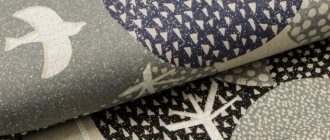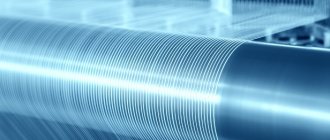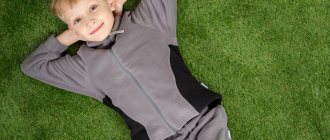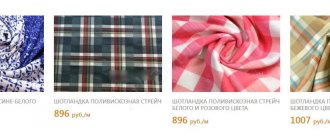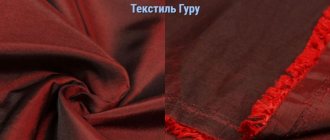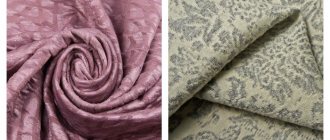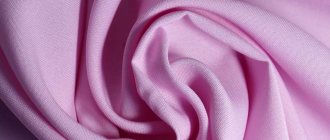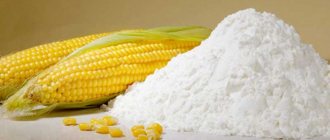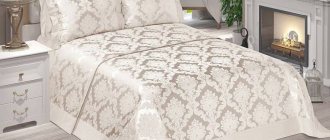What is membrane tissue
Among innovative synthetic materials with enhanced protective properties, membrane fabric occupies the first position. It allows excess moisture to be removed outside without letting drops of water inside.
The first samples appeared and were patented back in 1969. And later many analogues were developed. One of them is the material alova.
Membrane fabric is a high-tech invention. It is intended for people working in extreme conditions or for outdoor enthusiasts and performs important functions:
- provides reliable protection from adverse weather conditions (snow, rain, strong wind and frost);
- creates a comfortable microclimate near the surface of the skin, removes excess heat and fumes to the outside, preventing overheating or hypothermia of the body.
The membrane can be of two types:
- With an open porous structure. The diameter of each pore is smaller than a drop of water, but larger than the size of a water molecule;
- Hydrophilic (non-porous). This type attracts moisture, binds and transports liquid molecules through diffusion from the inner layer of the fabric to the outer layer.
Reference! There is also another type of expensive combined membranes. They are made on a hydrophobic basis with a thin layer of polyurethane applied on top.
Types of smart synthetics
Alova is classified according to 2 indicators: the type of front covering and the type of membrane. The top layer can be made of knitwear, materials with the simplest plain weave, raincoat fabric (the main difference is the water-repellent coating), umbrella fabrics (can be plain-dyed, with printed patterns, with additional varnish finishing).
Membrane film also has its own varieties.
| View | Peculiarities |
| Non-porous membranes | The outer layer does not allow moisture to pass through, but the inner layer removes it. Droplets of sweat settle on the film and are removed through diffusion. This coating does not start working immediately, but over time it copes with its task perfectly. The advantages include:
|
| Pore | The hole sizes are smaller than the size of a drop of water, but larger than the size of a vapor molecule. That is why moisture does not get inside, and evaporation is freely removed outside. Such films work as soon as a person begins to sweat. But pore membranes, if they are not properly cared for (for example, washed with a spin), quickly lose their properties. |
| Combined | Two-in-one option. Another pore-free polyurethane is applied on top of the pore membrane. This type has no disadvantages. But this technology is very expensive, so most enterprises try not to use it. |
Alova production process
Alova fabric - what is it and what raw materials are used to make it? The material is made from synthetic fibers using a special technology.
Helpful information:
Footer with lycra what kind of fabric
What kind of fabric is poplin?
Its main feature is the presence of several layers:
- The front side is made of polyester. Most often it is made by knitting, but can also be made from plain, umbrella or raincoat polyester fabric. The purpose of the outer layer is to ensure sufficient density and strength.
- On the inside there is a waterproof and steam-removing membrane film. It consists of synthetic polymers and is designed to stabilize heat and air flows.
Reference! In some samples, the third layer intended for insulation is a synthetic knitted fabric - fleece.
The essence of the production process is to heat the membrane film to a certain temperature and then adhere it under high pressure to the fabric base. This technology ensures strong, but at the same time flexible adhesion of all components, preventing their further delamination.
Production and raw materials
Alova is made of synthetic materials - the knitted layer is made of polyester, the membrane layer is made of synthetic polymers.
Under pressure, a membrane film heated to a certain temperature is applied to the fabric base and adheres tightly to it, forming adhesion.
Its outer layer, depending on its purpose, is a base made of knitted, umbrella, raincoat or linen material; most often, knitted fabric of various camouflage colors is used. The purpose of this layer is to provide strength, sufficient thickness and a beautiful appearance.
The scarlet fabric owes its remarkable properties to its inner layer. This is a membrane film made of synthetic polymers, which is both waterproof and vapor conductive. It is fixed using the high-pressure adhesion method. The adhesion is strong and flexible at the same time, and the membrane performs the function of automatically regulating heat and air flows near the surface of the body.
This fabric was developed for people working in extreme conditions, and numerous tests and reviews confirm that it provides reliable protection against cold and frost, wind and rain.
In this case, the membrane material:
- soft and beautiful;
- quite light;
- does not hinder movements;
- does not absorb water;
- does not freeze in cold weather.
Characteristics and properties
When describing alova fabric, mention should be made of its main characteristics:
- soft to the touch with a velvety texture;
- light;
- comfortable;
- hypoallergenic;
- breathable;
- durable and strong;
- wear-resistant;
- resistant to low temperatures and pathogenic microflora;
- does not get wet;
- does not hinder movements;
- does not rustle;
- not electrified.
This fabric protects not only from bad weather conditions, but also from insect bites. It has an attractive appearance, because its upper knitted layer is decorated with a print of natural brown, beige and greenish shades, which is a good camouflage.
The material also has many unique properties:
- Waterproof . This figure reaches 8 thousand mm of water column, the suit will not get wet even in heavy rain.
- Air permeability (breathability) . Equals 1.5 dm³/m² sec. The material protects well from gusts of wind, but at the same time allows the skin to breathe.
- Thermal insulation . The fabric reliably protects from the cold and at the same time retains heat inside the suit, preventing the body from overheating.
- Dirt resistance . The top layer is coated with a special dirt-repellent impregnation, which allows clothes to stay clean longer.
Another important property of the material is vapor permeability . And this feature is explained by the exceptional structure of the alova tissue, the membrane of which ensures the removal of vapors emitted by the body to the outside and at the same time does not allow moisture from the external environment to pass inside.
The fact is that simple water molecules tend to combine into more complex associates. Therefore, the pores of the membrane do not allow large formations to pass inside. And the sweat secreted by the human body, evaporating, contains only single molecules that easily pass through the membrane layer.
Reference! The vapor permeability value is 1000 g/m²/24 hours. Therefore, manufacturers warn that the feeling of comfort will remain only with moderate physical activity. You should not engage in active sports wearing suits made of scarlet fabric.
Fabric Features
Membrane matter has the following characteristics:
- Waterproof. It has the ability to withstand a humidity of 8000 mm water column; the membrane fabric does not allow moisture to penetrate. Clothes made from such protective material will not allow you to get wet in the pouring rain.
- Breathability. Thanks to this fabric, the skin breathes and is not blown through. The value of this indicator is 1.5 dm3/m2 sec.
- Vapor permeable fabric. This property means the ability to remove body fumes. This indicator is 1000 g/m2/24 hours.
- Thermal insulation. The fabric retains heat perfectly.
- Hypoallergenic properties. Does not cause allergies and protects against the spread of dust mites and microorganisms that may cause such reactions.
- Wear-resistant material. If you take proper care of the product, it can last a long time without losing its quality.
- Frost resistance. Alova membrane fabric is resistant to cold.
- Dirt-resistant material. The fabric has dirt-repellent properties.
- Easy to care for. Products made from it can be washed both in a washing machine and by hand, they are not subject to deformation or stretching, and do not shrink.
Care instructions
The material is resistant to stains, but its area of application requires frequent washing. Therefore, it is important to follow a number of recommendations that will allow you to keep your clothes in their original form for a long time and extend their service life:
- the material tolerates both machine and hand washing, but the water temperature should not exceed 30°;
- it is necessary to use special detergents that will not damage the membrane; in extreme cases, you can use liquid soap or regular shampoo;
- even in case of severe contamination, clothes made of aloe fabric should not be soaked;
- drying must be done exclusively in a natural way;
- The product can only be ironed on one side - the front side, and the temperature should be at a maximum of 110°.
If not properly cared for, the material may lose its unique properties, and the membrane will undergo deformation and no longer provide good protection.
It is strictly forbidden to:
- wash products using chlorine-containing, bleaching, powder products (powder granules can penetrate the pores of the membrane);
- dry things using heating devices or near heat sources.
Rules of care
The fabric is easy to care for. It practically does not get dirty, but regular washing is necessary to maintain its properties. To prevent matter from deforming and losing its properties, it is necessary to follow simple rules:
- You should familiarize yourself with the recommended care methods.
- Membrane materials should be washed in warm water. For this, manual and machine modes are used, but you should not soak clothes in advance.
- You will need special detergents or regular liquid soap.
- After this, the item is air dried.
- Ironing is done from the outside. The surface of the iron should not be heated above 110 degrees.
To prevent the material from losing its excellent properties, you should not use bleaches or products containing chlorine. Regular washing powder is not suitable for it. Because of such means, the material will quickly lose its neat appearance. You should not dry such clothes near heat sources; it is advisable to hang them outside. If you follow the rules of care, you will be able to maintain the attractive appearance and properties of this durable material.
Characteristics of membrane material: pros and cons
This fabric has the following properties:
- Hydrophobicity, the value of which is 8000 mm water. Art.
- High density. The level of this indicator, depending on the type of matter, varies from 180 to 280 g/sq.m. m.
- Air permeability equal to 1.5 sq. dm/sq. m x sec.
- Vapor permeability, the value of which is 1000 g/sq. m.
When describing alova, the following advantages are highlighted:
- Windproof.
- Free air exchange in the fibers. Thanks to this quality, products made from aloe are comfortable even in hot weather.
- Moisture resistance. Acting as a reliable barrier between the skin and moisture, the material does not create a greenhouse effect.
- The ability to retain heat generated by the human body.
- Wear resistance.
- Wide variety of colors. There are alova "winter" and "summer" colors.
- Low temperature resistance. In the cold it does not rustle or harden. This property is especially important when sewing hunting clothes.
- Hypoallergenic. The fabric does not provoke allergies, so products made from it can be used by allergy sufferers and asthmatics without any fear for their health.
- Dirt resistance. To protect against contamination, the surface of the material is treated with a special compound.
- Resistance to damage by pathogenic microorganisms.
- Form stability. Products made from alova retain their original shape even after repeated washing.
- Availability. Compared to most membrane fabrics, this material has a more affordable price.
- Antistatic. Alova does not accumulate static electricity.
- Easy to care for.
Alova manufacturers guarantee the preservation of high performance qualities only under moderate loads. According to reviews from numerous owners of clothes made from this fabric, it becomes uncomfortable if you move too actively, such as running for a long time.
